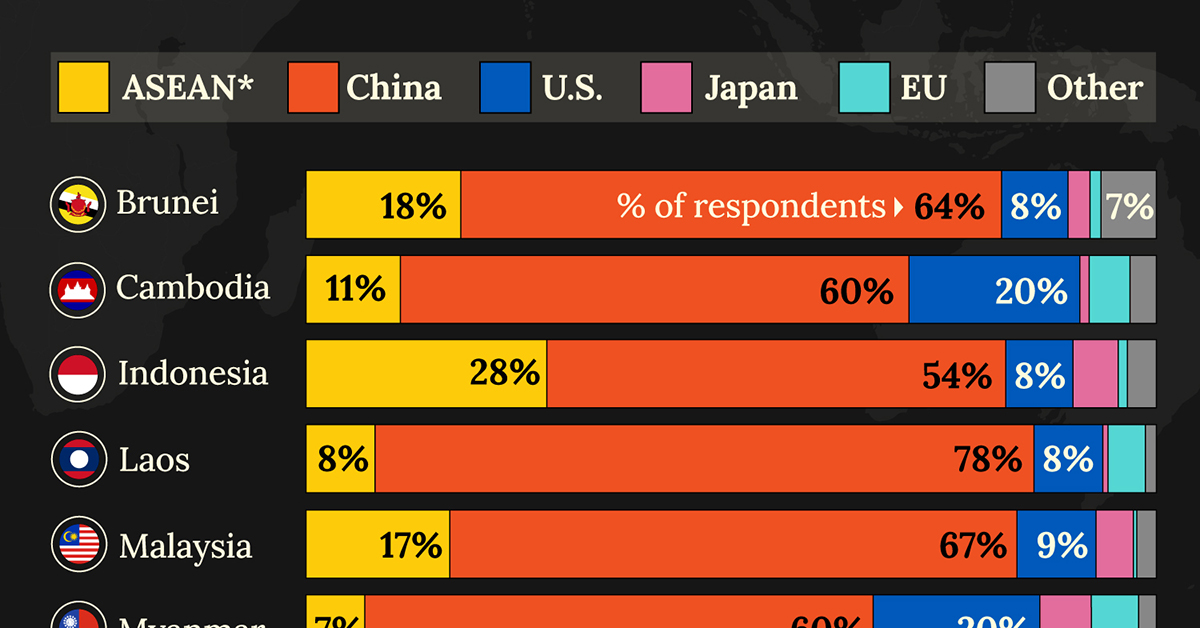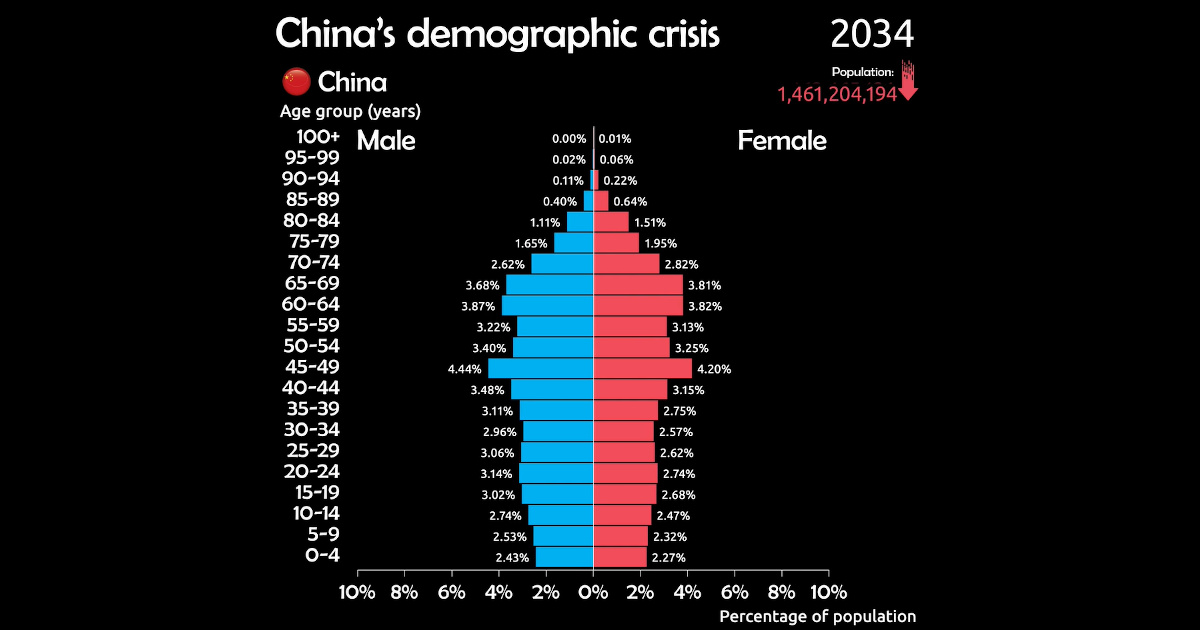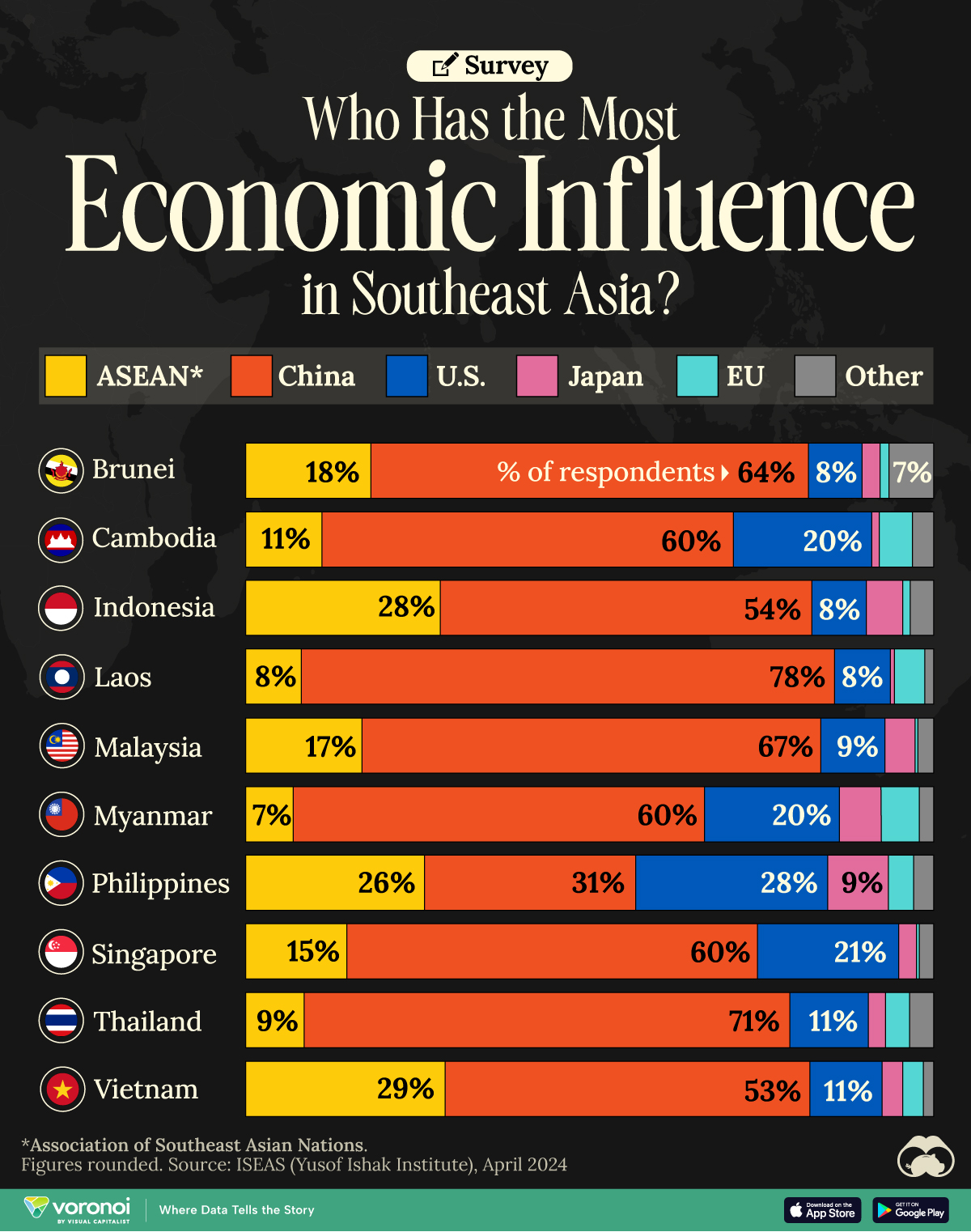China
Animated Chart: China’s Aging Population (1950-2100)
China’s Aging Population Problem
The one-child policy defined China’s demographic transition for over three decades.
But to combat an aging population and declining birthrates, the government scrapped the policy for a new two-child policy in 2016. Despite this massive change, China still faces a growing demographic crisis.
The above animated population pyramid from James Eagle looks at the distribution of China’s population by age group since 1950, with projections up to the year 2100.
How the One-Child Policy Created a Gender Imbalance
Until 2016, the Chinese government strictly enforced the one-child policy since 1979 with hefty fines for any breach of rules. According to the government, the policy reduced 400 million births over the years.
However, it also led to sex-selective abortions due to a deep-rooted cultural preference for boys. As a result, China’s gender balance tilted, with a sex ratio of 111 males to 100 females in the population aging from 0 to 4 years old in 2020.
Often termed “the missing women of China”, this shortage of women is expected to worsen over time. According to the U.N.’s World Population Prospects, China is projected to have around 244 million fewer women than men in 2050.
Additionally, the country faces another impending consequence of the one-child policy—a rapidly aging population.
Why China’s Population is Aging
In 2020, China’s fertility rate—the number of children a woman is expected to have over her lifetime—stood at 1.3.
Generally, fertility rates drop as economies develop. However, China’s fertility rate is now lower than that of the U.S. (1.64 in 2020) and on par with countries like Japan and Italy, both of which are facing aging populations. Consequently, fewer newborns are entering the population, while many in the workforce approach retirement.
Most Chinese workers retire by age 60. Here’s how China’s retirement-age population is expected to shape up by the year 2100:
| Year | 60+ Population | % of Total Population |
|---|---|---|
| 1980 | 74,899,385 | 7.5% |
| 2000 | 129,460,648 | 10.0% |
| 2021 | 258,371,810 | 17.9% |
| 2050 | 485,489,066 | 34.6% |
| 2070 | 454,270,458 | 36.1% |
| 2100 | 402,780,972 | 37.8% |
In 2021, people aged 60 and over made up nearly one-fifth of the Chinese population. As the country’s population begins declining around 2030, over 30% of all Chinese people are expected to be in this age group.
China’s aging population threatens long-term economic growth as its workforce shrinks and low fertility rates result in fewer newborns that would later enter the working-age population. Fewer working people means lower overall consumption, a higher burden on elderly care, and slowing economic growth.
So, how will China respond to the oncoming crisis?
The Three-child Policy
According to the 2020 national census, Chinese mothers gave birth to 12 million children in 2020—the lowest number of births since 1949.
In response to these results, the government passed a new law allowing each couple to have up to three children. Despite the change, the high cost of raising a child may deter couples from having a third child.
It remains to be seen how the three-child policy helps combat China’s demographic crisis and which other policies the government chooses to deploy.

This article was published as a part of Visual Capitalist's Creator Program, which features data-driven visuals from some of our favorite Creators around the world.
Politics
Which Countries Have the Most Economic Influence in Southeast Asia?
One country dominates this survey of who has the most economic influence in the region.

Countries With the Most Economic Influence in Southeast Asia
This was originally posted on our Voronoi app. Download the app for free on iOS or Android and discover incredible data-driven charts from a variety of trusted sources.
This chart visualizes the results of a 2024 survey conducted by the ASEAN Studies Centre at the ISEAS-Yusof Ishak Institute.
Nearly 2,000 respondents from 10 countries were asked to select which country/region they believe has the most influential economic power in Southeast Asia.
The countries surveyed are all member states of the Association of Southeast Asian Nations (ASEAN), a political and economic union of 10 countries in Southeast Asia.
Southeast Asia Perceptions: Who’s Got Economic Influence?
Across all ASEAN nations, China is regarded as the region’s most influential economic power.
Laos and Thailand had the highest share of respondents picking China, at 78% and 71% respectively. As the report points out, China is Laos’ largest foreign investor as well as its top export market.
| Country | 🇨🇳 China | 🌏 ASEAN | 🇺🇸 U.S. |
|---|---|---|---|
| 🇧🇳 Brunei | 64% | 18% | 8% |
| 🇰🇭 Cambodia | 60% | 11% | 20% |
| 🇮🇩 Indonesia | 54% | 28% | 8% |
| 🇱🇦 Laos | 78% | 8% | 8% |
| 🇲🇾 Malaysia | 67% | 17% | 9% |
| 🇲🇲 Myanmar | 60% | 7% | 20% |
| 🇵🇭 Philippines | 31% | 26% | 28% |
| 🇸🇬 Singapore | 60% | 15% | 21% |
| 🇹🇭 Thailand | 71% | 9% | 11% |
| 🇻🇳 Vietnam | 53% | 29% | 11% |
Note: Percentages are rounded.
Other ASEAN countries usually score highly as well, along with the United States.
It’s only in the Philippines, where China (31%), the U.S. (28%) and ASEAN (26%) were perceived as having a similar amount of influence.
ASEAN, Japan, and the EU
Filipinos also rated Japan’s economic influence the highest (9%) compared to those surveyed in other ASEAN countries. In 2023, the Southeast Asian bloc celebrated 50 years of friendship with Japan, marking it as one of their most important “dialogue partners.”
| Country | 🇯🇵 Japan | 🇪🇺 EU | 🌐 Other |
|---|---|---|---|
| 🇧🇳 Brunei | 3% | 1% | 7% |
| 🇰🇭 Cambodia | 1% | 5% | 3% |
| 🇮🇩 Indonesia | 5% | 1% | 3% |
| 🇱🇦 Laos | 1% | 4% | 1% |
| 🇲🇾 Malaysia | 4% | 0% | 2% |
| 🇲🇲 Myanmar | 6% | 6% | 2% |
| 🇵🇭 Philippines | 9% | 4% | 3% |
| 🇸🇬 Singapore | 3% | 0% | 2% |
| 🇹🇭 Thailand | 3% | 4% | 4% |
| 🇻🇳 Vietnam | 3% | 3% | 2% |
Note: Percentages are rounded. Other countries include: Australia, South Korea, India, and the UK.
The EU also received single-percentage responses, its highest share coming from Myanmar (6%), Cambodia (5%), and Laos (4%).
Finally, the report contrasted China’s robust economic influence with concerns about its growing impact in the region. Respondents from Vietnam (88%), Myanmar (88%), and Thailand (80%) had the highest levels of concern, despite their countries’ strong trade ties with China.
-

 Personal Finance1 week ago
Personal Finance1 week agoVisualizing the Tax Burden of Every U.S. State
-

 Misc6 days ago
Misc6 days agoVisualized: Aircraft Carriers by Country
-

 Culture7 days ago
Culture7 days agoHow Popular Snack Brand Logos Have Changed
-

 Mining1 week ago
Mining1 week agoVisualizing Copper Production by Country in 2023
-

 Politics1 week ago
Politics1 week agoCharted: How Americans Feel About Federal Government Agencies
-

 Healthcare1 week ago
Healthcare1 week agoWhich Countries Have the Highest Infant Mortality Rates?
-

 Demographics1 week ago
Demographics1 week agoMapped: U.S. Immigrants by Region
-

 Economy1 week ago
Economy1 week agoMapped: Southeast Asia’s GDP Per Capita, by Country













